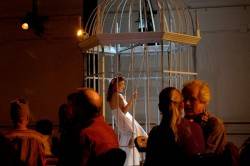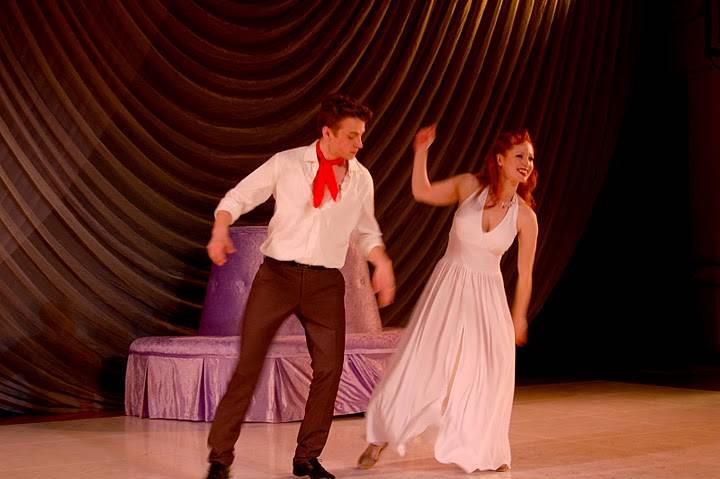I walk through the winding, cinderblock hallways deep in the Krannert Center’s Level 2, past the men and women dressed in elaborate costumes, towards the trance music with a heavy bass. As I walk through the open door into the dark room I am transported to 19th century France, in the seedier part of town. You can almost taste the Absinthe.
 Ginger Brûlée, Sonia Warfel’s stage name and the woman who put together this night of debaucherous and bawdy burlesque, greets the audience while swaying on a swing in a fifteen foot bird cage. She wears an elegant, white dress and her deep, red hair is done up with a slight nostalgic feel. As she swings back and forth, Ginger Brûlée does not look terrified, like someone trapped, but confident like she knows she can free herself from this cage whenever she is ready. Which really is the point.
Ginger Brûlée, Sonia Warfel’s stage name and the woman who put together this night of debaucherous and bawdy burlesque, greets the audience while swaying on a swing in a fifteen foot bird cage. She wears an elegant, white dress and her deep, red hair is done up with a slight nostalgic feel. As she swings back and forth, Ginger Brûlée does not look terrified, like someone trapped, but confident like she knows she can free herself from this cage whenever she is ready. Which really is the point.
Voulez-Vous Brûlée, a night of neo-burlesque performance, was created as a semi-autobiographical night of dance following “a young performer who enters a prison of her own making and ultimately contrives her escape,” Sonia says.
Sonia says she has been studying dance all her life. She received her BFA in dance from New York University and performed all around the U.S. and Europe. After marrying her husband Andy Warfel, co-producer and production designer for the show, Sonia all but gave up dance. Instead she focused her creativity on more traditional roles. After living in New York for 12 years, Sonia moved to the Midwest. Eventually she settled in Urbana and started her masters in dance, which she is now finishing. She teaches tap and performs modern dance. And right now she is feeding her interest in burlesque.
Despite what most people think, (including myself before I interviewed Sonia) burlesque is not just about strip tease. Sonia says it has roots in comedy and Vaudeville. Burlesque uses satire and sexuality to make a mockery of an aspect of the culture.
Neo-burlesque takes that same sense of humor, mixed with nostalgia, and discuses issues that were even taboo for the original dancers, such as queer theory and gender representation, Sonia says. “It’s a bit more broad in it’s social commentary,” Sonia says.

Although the show is sanctioned by the university, it still feels a little forbidden. The show took place in the basement of the Krannert Center. While dressed up theater goers watched “A Midsummer Night’s Dream” or the Champaign-Urbana Symphony Orchestra, dancers make provocative statements about motherhood below. And except for Jordan Shevell, who danced a wonderful tap duet with Sonia, all the dancers went by their burlesque name. This was part nod to original burlesque dancers who needed anonymity and part protection in the current world of social transparency.
The show, which took place on March 5th, is technically Sonia’s master’s thesis, which completes her MFA in dance for the U of I. The real show, she says, will be on the 17th when the public can see the full show at the Canopy Club.
“One of the elements of the show that really can’t be replicated in the small rehearsal space . . . is that it is all building towards a big dance party,” she says.








